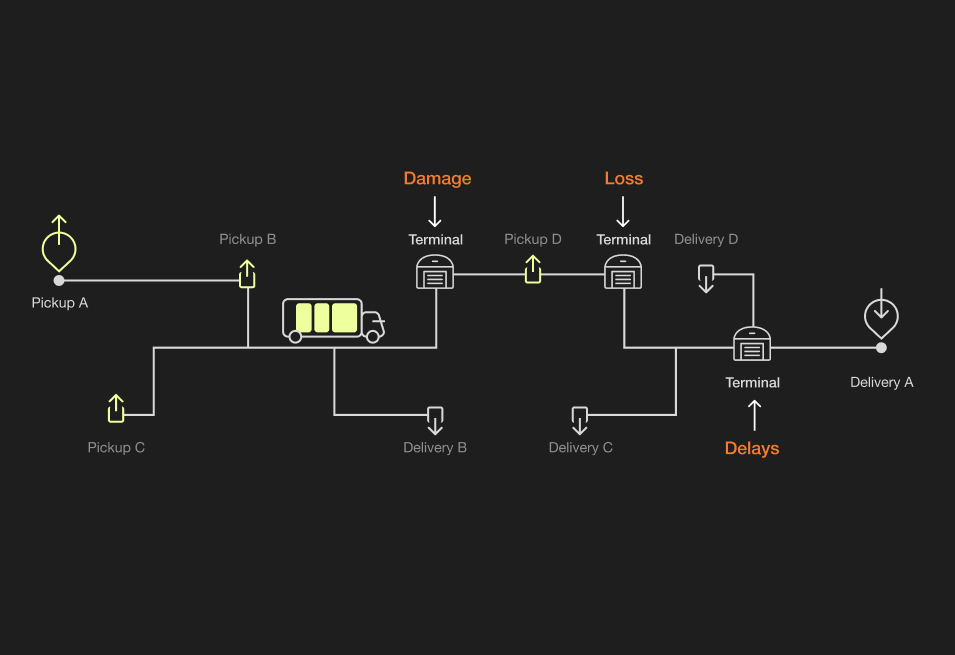Is LTL Freight Shipping Right for Your Small Business?

Shipping is an added expense for every company, and many small businesses are looking for ways to lighten the load. There are several strategies to reduce shipping costs—including extending delivery windows, optimizing routes, or using a third-party insurer.Another important step towards reducing small business shipping costs is to make sure you’re using the right shipping mode for the size and type of your shipment.
What is LTL freight shipping?
One method that’s often used to send smaller quantities of freight that would not fill an entire truck is less than truckload (LTL) freight shipping. While this shipping option can take longer to reach its final destination than a full truckload (FTL), LTL freight shipping can be a good mode for small businesses as it’s cheaper than paying for a truckload when you can’t fill it.
How does LTL freight shipping work?
LTL freight shipping takes multiple smaller shipments from different customers and combines them at a hub warehouse to ship to a different warehouse. That process repeats, going from warehouse to warehouse until the packages arrive at their final destination.The shipping process begins with customers contacting a freight carrier to request a pickup. The shipper will then provide the carrier with information about the shipment, including:
- Pick up location
- Delivery address
- Shipment weight
- Type of shipment
- Special instructions
The carrier will then assign a truck that has enough capacity to accommodate the shipments, usually a smaller locally-operated truck, and will pick up the freight from your location. After that, the packages go to a central hub where they’re moved onto larger, long-haul trucks. Those trucks move to a freight terminal where shipments are transferred and rearranged onto different trucks based on their destination. Once the trucks arrive at a destination terminal, packages are moved to local delivery trucks and delivered to their final destination.
Considerations to make for LTL freight shipping
LTL freight shipping can save money compared to booking a full truckload, but it may not always be the right choice for your shipments. Shipments will take longer to arrive at the final destination and items are more prone to damages via LTL freight. If you do decide to use LTL freight shipping, you’ll need to find a carrier, determine the right packaging, and learn whether the schedule fits your customers’ needs.
Packaging
Your products will ship by the pallet, so keep that in mind as you determine how you’ll package them. The larger the packaging, the fewer you’ll fit. Make each one as small as possible to take up less space—they’ll also end up weighing less if you’re not using excess packing material, meaning you’ll pay less for weight. Instead of using extra cardboard boxes, ship products in their original packaging with shipping labels. You also need to consider the vulnerability of the products. Your packages will be transferred from truck to truck, which increases the risk of potential damage. If your packages are fragile, add more materials to protect them, like bubble wrap or packing paper.
Shipment tracking
Online tracking may not be as precise as you need when it comes to LTL shipping, since packages are transferred from truck to truck. Before deciding on a specific carrier, determine what kind of shipment tracking capabilities they offer, like online tracking and tracking by bill of lading, a progressive number, and a purchase order number. These specific tracking capabilities often get you a more precise location than online tracking. Getting a precise location is important, as you need to be able to track shipments in case customers have questions about their packages—and to make sure things are arriving on time so you can proactively send them shipping updates.
Freight classification
Getting your freight class right is key to getting accurate LTL shipping rates from your carrier. Your shipment will fall into one of 18 different freight categories ranging from 50 to 500. If your items have a high density, they’ll have a lower classification. Low-density items have a higher classification.Along with freight class, your items will also get a code that’s determined by the National Motor Freight Classification (NMFC). While freight classes represent a certain category of items, NFMC codes represent specific items within that category. These codes let LTL shippers know how easy it will be to ship your packages. NFMC codes are given based on:
- Handling: Handling refers to how difficult it is to move a shipment from one place to another. If an item is fragile and needs special care, that affects its NFMC code.
- Liability: If your products are hazardous or could potentially damage other packages, then that affects liability. The higher the liability, the more expensive it will be to ship.
- Density: Higher-density items are easier to ship than lower-density ones that might be more bulky. For example, nuts and bolts are easier to ship than flat-screen TVs.
- Stowability: Stowability indicates how easily a shipment can fit into the space available in a truck. Factors such as shape, size, and weight all play a role in determining stowability.
Carriers
Get bids from multiple shipping carriers so you can compare them before making the final decision. What are their base competitive rates? What about associated costs like weight of shipment, minimum charges, and accessorial fees? These questions will allow you to compare several bids and find the best rate for your shipments. See what differentiators they may have outside of pricing, too. One carrier might be able to ship hazardous items, but may not be able to offer you advanced tracking capabilities.
Planning and scheduling
LTL shipping can take longer than full truckload, so plan ahead for that. Prepare your customer for larger delivery windows and tell them upfront what the shipping time frame is. If you promise a small delivery window and the package doesn’t arrive within that time, you risk customers being unsatisfied.
Benefits of LTL freight shipping
When you ship via LTL, there are several benefits you can expect, such as:
- Cost Savings: LTL shipping is often the most cost-effective way to ship packages. By utilizing an LTL carrier, you are able to save on shipping costs since you are only paying for the amount of space they require in the truck, as opposed to a full truckload.
- Trackability: LTL carriers have advanced tracking systems that allow customers to easily track the progress of their shipment.
- Delivery Options: LTL carriers provide customers with a variety of delivery options, such as residential delivery, appointment delivery, and even inside delivery.
Downsides of LTL freight shipping
While LTL has its benefits, there are downsides to using this freight service, mainly:
- Longer Delivery Times: The delivery times for LTL shipments can be longer than those for full truckload shipments, because LTL shipments often require multiple stops along the way.
- Increased Damage Risk: Since LTL shipments are often handled multiple times during transit, there is an increased risk of damage or loss.
- Accessorial Fees: You may incur an accessorial fee if your measurements or classifications are wrong, and these add up quickly. A recent Flock Freight study found that shippers spend more than $400,000 each year on accessorial fees alone.
Use STL shipping as an alternative to LTL
An even better alternative to LTL freight shipping is shared truckload (STL). Flock Freight’s patented technology pairs you with the perfect shipping solution to send your products via a shared truck. We use proprietary algorithms to find the best spot for your load so that your goods are moved on hubless routes and delivered on time 30% more often than through LTL shipping. Plus, with STL shipping, your freight arrives damage-free 99.8% of the time. If you’re ready to learn more about how we can help you streamline the way you ship your packages and save money, contact us today to set up a demo.





